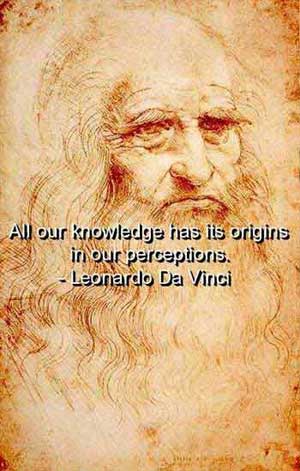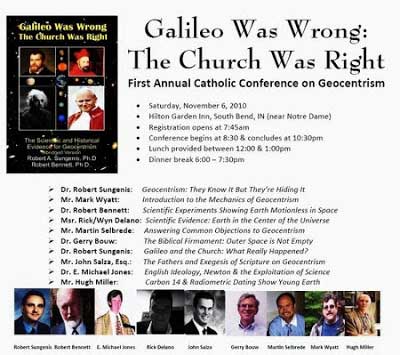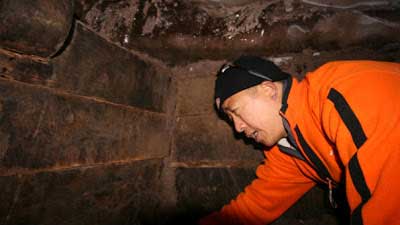
Leonardo the Questioner
Leonardo did not seem very pleased with the Roman Catholic Church, nor very interested in theology:
“In Leonardoʼs time, the late 1400s, there was no formal scientific research. Scholars instead unquestioningly accepted the observations of nature that were passed down from Aristotle and other ancient Greeks. In fact, Pope Leo X interfered with da Vinciʼs beloved autopsies, prohibiting him from further dissections. Thus, Leonardoʼs great studies on the human body were terminated, never to be resumed with the same intensity.” (Nuland, Sherwin. Leonardo da Vinci. New York: Penguin Books, 2005, p. 94).
As Leonardo wrote:
Those who try to censor knowledge do harm to both knowledge and love, because love is the offspring of knowledge, and the passion of love grows in proportion to the certainty of knowledge. The more we know about nature, the more we can be certain of what we know, and so the more love we can feel for nature as a whole.
Of what use are those who try to restrict what we know to only those things that are easy to comprehend, often because they themselves are not inclined to learn more about a particular subject, like the subject of the human body.
And yet they want to comprehend the mind of God, talking about it as though they had already dissected it into parts. Still they remain unaware of their own bodies, of the realities of their surroundings, and even unaware of their own stupidity.
Along with the scholars, they despise the mathematical sciences, which are the only true sources of information about those things which they claim to know so much about. Instead they talk about miracles and write about things that nobody could ever know, things that cannot be proven by any evidence in nature.
Leonardo thought the Church was scamming its less sophisticated members: “Leonardo objected to the commercial exploitation of relics, religious art, and pious items, saying, ‘I see Christ once more being sold and crucified and his saints martyred.’ In his notebooks and letters, he protested the sale of indulgences, liturgical and ceremonial pomp, obligatory confessions, and the cult of the saints. He assailed the clergy—at all levels—for their lack of morality, values, and education. As a scientist, he questioned the contemporary reality of miracles performed by priests and monks.” (Apostolos-Cappadona, Diane. “Leonardo: His Faith, His Art.” Before 2 Nov. 2009. 26 Jan. 2010)
Leonardo liked to poke fun at silly religious beliefs and practices. The following jest is found in one of his notebooks:
A priest going the round of his parish on Saturday before Easter, sprinkling holy water in the houses as was his custom, came to a painterʼs room and there sprinkled the water upon some of his pictures. The painter, turning round somewhat annoyed, asked him why this sprinkling had been bestowed on his pictures; then the priest said that it was the custom and that it was his duty to do so, that he was doing good, and that whoever did a good deed might expect a return as good and better; for so God had promised that every good deed that was done on earth shall be rewarded a hundredfold from on high. Then the painter, having waited until the priest had walked out, stepped to the window above, and threw a large bucket of water to his back, saying: Here is the reward a hundredfold from on high as you said would come from the good you did me with your holy water with which you have damaged half my pictures (Gelb, Michael. Da Vinci Decoded. New York: Bantam Dell, 2004, p. 18).
Leonardo expressed doubts about the literal interpretation of the Bible. For example, in the eighteen pages of his notebooks that Bill Gates purchased for $30.8 million, Leonardo questioned the biblical story of a one-year long flood that allegedly “covered the highest mountains” all around the world:
Here a doubt rises, and that is: whether the Flood which came at the time of Noah was universal or not. And it would seem not, for the reasons which will now be given. We have it in the Bible that this deluge lasted 40 days and 40 nights, of incessant and universal rain, and that this rain rose to ten cubits about the highest mountains in the world. And if it had been that the rain was universal, it would have covered our globe which is spherical in form. And this spherical surface is equally distant in every part from the centre of its sphere; hence the sphere of the waters being under the same conditions, it is impossible that the water upon it should move, because water, in itself, does not move unless it falls; therefore how could the waters of such a deluge depart, if it is proved that it has no motion? And if it departed how could it move unless it went upwards? Here, then, natural reasons are wanting; hence to remove this doubt it is necessary to call it a miracle to aid us, or else to say that all this water was evaporated by the heat of the sun. (Gelb 16-17)
Leonardo found evidence in fossils, rock formations, and the movements of water that the Earth was much older than the Bible and Roman Catholic Church taught: “Recognizing the fossils as remains of once-living organisms,… Leonardo reasoned that such fragile shells could not have been swept so far inland and survived intact. He also noted that the fossils commonly lay in successive rock layers, evidence that they were deposited by multiple events rather than by only one. And he observed that groups of different fossil shells found together resembled the living groups assembled in coastal waters. For all these reasons, Leonardo correctly concluded that the fossils came from animals which once inhabited an ancient sea that covered the land.”
In his own words, Leonardo says:
Since things are far more ancient than letters, it is not to be wondered at if in our day there exists no record of how the aforesaid seas extended over so many countries; and if, moreover, such record ever existed, the wars, the conflagrations, the deluges of the waters, the changes in speech and habits, have destroyed every vestige of the past. But sufficient for us is the testimony of things produced in the salt waters and now found again in the high mountains far from the seas. (Nuland 106)
Perhaps most impressive is the mysterious phrase, “The sun does not move,” which stands by itself in capital letters among his writings. It is likely that da Vinci correctly concluded before Copernicus and Galileo that the sun, not the Earth, is the center of the solar system.
Leonardo the Empiricist
Marco Rosciʼs biography, Leonardo, notes that Leonardo “adopted an empirical approach to every thought, opinion, and action and accepted no truth unless verified or verifiable, whether related to natural phenomena, human behavior, or social activities.”
Leonardo wrote:
It seems to me that all studies are vain and full of errors unless they are based on experience and can be tested by experiment, in other words, they can be demonstrated to our senses. For if we are doubtful of what our senses perceive then how much more doubtful should we be of things that our senses cannot perceive, like the nature of God and the soul and other such things over which there are endless disputes and controversies.
Wherever there is no true science and no certainty of knowledge, there will be conflicting speculations and quarrels. However, whenever things are proven by scientific demonstration and known for certain, then all quarreling will cease. And if controversy should ever arise again, then our first conclusions must have been questionable.
Although nature commences with reason and ends in experience it is necessary for us to do the opposite, that is to commence with experience and from this to proceed to investigate the reason.
Study the science of art. Study the art of science. Develop your senses—especially learn to see. Realize that everything connects to everything else.
Anyone who conducts an argument by appealing to authority is not using his intelligence; he is just using his memory.
I am well aware that because I did not study the ancients, some foolish men will accuse me of being uneducated. They will say that because I did not learn from their schoolbooks, I am unqualified to express an opinion. But I would reply that my conclusions are drawn from firsthand experience, unlike the scholars who only believe what they read in books written by others.
Although I cannot quote from authors in the same way they do, I shall rely on a much worthier thing, actual experience, which is the only thing that could ever have properly guided the men that they learn from.
These scholars strut around in a pompous way, without any thoughts of their own, equipped only with the thoughts of others, and they want to stop me from having my own thoughts. And if they despise me for being an inventor, then how much more should they be despised for not being inventors but followers and reciters of the works of others.
When the followers and reciters of the works of others are compared to those who are inventors and interpreters between Nature and man, it is as though they are non-existent mirror images of some original. Given that it is only by chance that we are invested with human form, I might think of them as being a herd of animals.
Man discourseth greatly, and his discourse is for the greater part empty and false; the discourse of animals is small, but useful and true: slender certainty is better than portentous falsehood.
The greatest deception men suffer is from their own opinions.
Leonardo the “Buddhist” source
Da Vinci wrote some very Buddhist-sounding principles in his Principles for the Development of a Complete Mind:
There are three classes of people: those who see, those who see when they are shown, those who do not see.
The noblest pleasure is the joy of understanding.
The Buddhaʼs Right Intention and Right Effort focus on making a commitment to mental and ethical self-improvement. Learning to substitute desire and anger with the intention of goodwill and compassion will make us better humans. Leonardo said:
You will never have a greater or lesser dominion than that over yourself… The height of a manʼs success is gauged by his self-mastery; the depth of his failure by his self-abandonment… and this law is the expression of eternal justice. He who cannot establish dominion over himself will have no dominion over others.
And Leonardo saw the ongoing search for knowledge as a duty:
Iron rusts from disuse; stagnant water loses its purity and in cold weather becomes frozen; even so does inaction sap the vigor of the mind. So we must stretch ourselves to the very limits of human possibility. Anything less is a sin against both God and man.
[Many] have made a trade of delusions and false miracles.
Where there is shouting, there is no true knowledge.
The Buddhist idea of Right Speech encourages followers to abstain from lies, slander, gossip, and harsh language that hurts others. Rather, the goal should be to help others. Right speech to a painter would also cover his art, thus da Vinci wrote:
A painter should begin every canvas with a wash of black, because all things in nature are dark except where exposed by the light.
Art is the queen of all sciences, communicating knowledge to all the generations of the world.
Buddhaʼs Right Action, what is often referred to today as Loving-kindness, teaches us to be honest and compassionate, respect others, and abstain form taking life. Da Vinci points out that
He who does not oppose evil… commands it to be done.
I have been impressed with the urgency of doing. Knowing is not enough; we must do.
And he seemed to be encouraging Buddhist-like vegetarianism with
I have from an early age abjured the use of meat, and the time will come when men such as I will look upon the murder of animals as they now look upon the murder of men… [and that his body] will not be a tomb for other creatures.
Buddhism teaches that all life is suffering, but that we bring on that suffering ourselves by wanting something that cannot be. Life will always bring unwanted change, illness, and, eventually, death. We can suffer less by accepting that these things will happen and giving up trying to change that. We canʼt always get what we want, but that doesnʼt mean we shouldnʼt have goals. We just have to realize that things may not go as planned. Leonardo encouraged going with the flow:
As you cannot do what you want, want what you can do.
I love those who can smile in trouble, who can gather strength from distress, and grow brave by reflection. ‘Tis the business of little minds to shrink, but they whose heart is firm, and whose conscience approves their conduct, will pursue their principles unto death.’
Life is pretty simple: you do some stuff. Most fails. Some works. You do more of what works. If it works big, others will quickly copy it. Then you do something else. The trick is the doing of something else.
Consider mindfulness - the idea of devoting 100% of your attention to what you are doing at the present moment. The idea is that our minds are wandering all over the place so much of the time, worrying about what has been or what may be in the future, that we donʼt even notice what we are really doing as we move through life. The Buddha taught that we should pay careful attention to what is going on in our bodies and all around us so that we donʼt miss the opportunity to see things as they really are. Leonardo once said that
The average human looks without seeing, listens without hearing, touches without feeling, eats without tasting, moves without physical awareness, inhales without awareness of odor or fragrance, and talks without thinking.
Finally, a life dedicated to seeing and understanding the world around us, doing what we can to help those less fortunate than ourselves, and sharing love and joy and knowledge, is a life well-lived. Da Vinci may have been having similar thoughts when he said:
Just as a well-filled day brings blessed sleep, so a well-employed life brings a blessed death.
Leonardo the… WTF?!
Leonardo boasted that he once painted a Madonna so beautiful that the man who bought it was haunted by unseemly thoughts. Even after it was altered, perhaps with the addition of crosses and saintly symbols (as was done in Leonardoʼs second version of The Virgin of the Rocks), it still gave him an erection when he tried to pray. So in the end he returned the painting to Leonardo, who delighted in this pornographic triumph.
And here we have an erotic drawing by Leonardo da Vinci. Itʼs called “Angelo incarnato” or “Angel incarnate” or angel made flesh (the penis is discolored because somebody tried to erase it at some point): (Not Safe For Work Picture)
Additional sources cited:
Da Vinci the deist.



